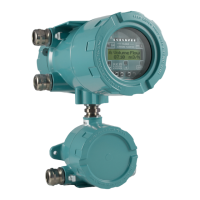16 Advanced functions
FLUXUS F501 16.9 Activation of a binary output as alarm output
109
UMFLUXUS_F501V1-3EN, 2020-06-30
16.9.1 Alarm properties
The switching condition, the holding behavior and the switching function of an alarm output can be defined.
The following 3 scroll lists are displayed:
• func: switching condition
• typ: holding behavior
• mode: switching function
Press key to select a scroll list in the upper line. Press key to select a list item in the lower line.
• Press ENTER to store the settings.
16.9.2 Setting the limits
If the switching condition MIN or MAX is selected in the scroll list func, the limit of the output has to be defined:
• Select the physical quantity to be used for the comparison in the scroll list Input. The following list items are available
for the alarm output R1:
– selected physical quantity
– signal amplitude
– sound speed of the fluid
• Press ENTER.
Tab. 16.1: Alarm properties
alarm property setting description
func
(switching condition)
MAX The alarm will switch if the measured value exceeds the upper limit.
MIN The alarm will switch if the measured value falls below the lower limit.
+→- -→+ The alarm will switch if the flow direction changes (sign change of measured value).
QUANT. The alarm will switch if totalizing is activated and the totalizer reaches the limit.
ERROR The alarm will switch if a measurement is not possible.
OFF The alarm is switched off.
typ
(holding behavior)
NON-HOLD If the switching condition is no longer true, the alarm will return to the idle state after
approx. 1 s.
HOLD The alarm remains activated even if the switching condition is no longer true.
mode
(switching function)
NO Cont. The alarm is energized if the switching condition is true and de-energized if idle.
NC Cont. The alarm is de-energized if the switching condition is true and energized if idle.
Notice!
If no measurement is made, all alarms will be de-energized, independently of the programmed switching function.
R1 Input\Mass Flow
R1=FUNC<typ mode
Function: MAX
